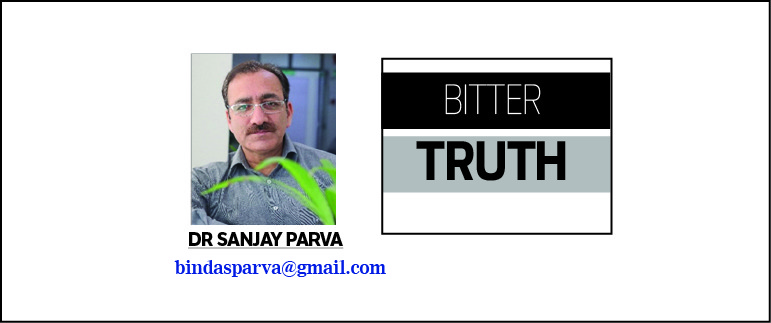By: Mohd Amin Mir
In the heart of rural Jammu & Kashmir, where every kanal of land is a lifeline, the subtle handwriting in the tenancy column of a Jamabandi or a Girdawari can determine who tills the soil, who claims the crop, and ultimately, who controls the land. These tenancy entries—meant to reflect lawful possession and usage—have, over decades, evolved into points of contention, confusion, and at times, covert manipulation.
Despite multiple rounds of land reforms, modernization drives, and now the sweeping digitization of land records under portals like WALHARUS, the integrity of this crucial column remains compromised. In hundreds of survey numbers across the region, the tenancy status in the Jamabandi differs from that in the Girdawari. These mismatches not only muddle ground realities but also distort court proceedings, mutation entries, and inheritance claims.
This article delves deep into the importance and legal standing of the tenancy columns, exposes why discrepancies persist, and proposes a rigorous path toward correction.
Understanding the Columns: A Primer on Revenue Records
What is the Tenancy Column in a Jamabandi?
The Jamabandi—a record-of-rights prepared every four years—contains a detailed description of every parcel of land within a village. It includes:
Name of the owner(s)
Khewat/Khatoni numbers
Survey (Khasra) numbers
Type of land
Area and revenue
Tenancy column: indicating names of tenants (if any), whether occupancy tenants, non-occupancy tenants, or sharecroppers
This tenancy column is vital because it legally recognizes actual cultivation by a non-owner and can form the basis for tenancy rights, land-to-tiller claims, and even ownership transitions under past reforms.
What is Girdawari and Its Tenancy Record?
Girdawari is a seasonal crop inspection report, recorded by the Patwari thrice a year (Rabi, Kharif, and Zaid seasons). It notes:
- Who is cultivating the land
- What crops are being sown
- Nature of possession—owner, tenant, lessee, or unauthorized occupant
The Girdawari’s tenancy column is more immediate and dynamic, reflecting seasonal reality, unlike the Jamabandi, which is a static, consolidated record.
The Importance of Tenancy Columns: More Than Just Names
The tenancy column is not merely administrative—it has social, economic, and legal consequences:
- Inheritance and Mutation Rights
Courts and revenue officers rely on Jamabandi tenancy records to establish rightful heirs, assess possession, and adjudicate land disputes.
- Protection under Agrarian Reforms Act
Cultivators recorded as tenants in Girdawari before 1971 gained ownership rights under the J&K Agrarian Reforms Act, 1976. Hence, tenancy entries formed the foundation for land redistribution.
- Eviction and Compensation Disputes
Disputed tenancy status complicates eviction proceedings. Tenants recorded in the Jamabandi or Girdawari may claim protection against unlawful eviction or demand compensation.
- Lease Agreements and Loans
Many banks verify tenancy or cultivation records before issuing agricultural loans. Mismatches jeopardize farmers’ financial eligibility.
- Digital Land Record Validation
Under land digitization efforts, contradictory entries in Jamabandi and Girdawari are leading to confusion in the WALHARUS and revenue court databases.
Mismatch Between Jamabandi and Girdawari: A Hidden Epidemic
Field surveys and anecdotal evidence reveal a disturbing trend—tenancy entries in Jamabandis do not match those in Girdawaris in a substantial number of villages. For instance:
In Survey No. 112 in a village in Anantnag, Jamabandi shows no tenancy, yet Girdawari shows Ali Mohammad S/o Noor Mohammad as tenant since 2009.
In Qazigund, a Jamabandi entry mentions a tenant from the 1980s who has long passed away, but the Girdawari continues to reflect his name with no seasonal updates.
Systemic Causes of the Mismatch
- Outdated Jamabandis
Many villages haven’t had their Jamabandi updated in over a decade, despite legal requirements for quinquennial revisions.
- Irregular or Fake Girdawaris
Patwaris sometimes fail to conduct spot inspections, instead entering names based on oral claims or local influence.
- Failure to Incorporate Mutations
Even when tenancy is legally altered through a decree or mutation, updates in both Jamabandi and Girdawari are rarely synchronized.
- Discretionary Girdawari Manipulation
Influence, money, or family disputes often lead to tampered Girdawaris that override rightful tenants recorded in Jamabandis.
- Lack of Synchronization During Digitization
The digital records created under WALHARUS sometimes uploaded one set of data (often Jamabandi) without reconciling contradictions with Girdawari.
Legal Validity: Which Record Prevails?
Courts across J&K have taken varying positions:
In several cases, courts have treated Jamabandi as superior, considering it part of the certified record-of-rights, prepared through statutory oversight.
However, in other judgments, especially where Girdawari entries are contemporaneous, consistent, and unchallenged, courts have favored Girdawari as reflecting actual possession.
For instance, the J&K High Court in Ghulam Rasool vs State (2011) accepted Girdawari as reliable evidence of tenancy where Jamabandi was outdated.
Thus, courts often weigh continuity, authenticity, and recency when evaluating which record holds legal weight.
Consequences of Inaccurate Tenancy Records
Disruption of Fair Litigation
Tenants omitted from records risk losing possession through manipulation or without due process.
Agricultural Distress
Erroneous entries result in denial of crop compensation or exclusion from government subsidies.
Inheritance Conflicts
Family disputes over tenancy cannot be resolved without trustworthy, updated records.
Corruption and Land Grabs
Falsifying Girdawari or ignoring tenancy in Jamabandi has become a tool for illegal land acquisition.
The Road to Reform: Correcting the Columns
To restore trust in revenue records, the following seven-point reform roadmap is proposed:
- Mass Verification Drives Before WALHARUS Uploads
Conduct field-based Girdawaris in presence of landowners, tenants, Lambardars, and Chowkidars. Reconcile both Girdawari and Jamabandi before digitization.
- Re-Notifying Tenancy Mutations
Direct Tehsils to revisit and verify past tenancy mutations. Field staff must confirm whether those tenants still hold possession.
- Automatic Flagging in Software
Build AI-powered systems into WALHARUS to flag mismatches between Jamabandi and Girdawari for human review.
- Village-Level Public Display of Draft Records
Post draft records in Panchayat offices and allow a 15-day window for public objections and corrections.
65 Legal Awareness Campaigns in Rural Areas
Educate tenants on their legal rights, especially where their names are silently removed or distorted in records.
- Aadhaar Integration and Geotagging
Modern Girdawaris should include biometric identity of cultivators. Use GPS-linked apps to tag land plots and record real-time crop data.
Commendation and Optimism: A New Era of Credibility
In the midst of this complex challenge, it is worth acknowledging the visionary leadership and hands-on efforts of the Financial Commissioner Revenue and the Commissioner Secretary Revenue of Jammu & Kashmir. Their guidance has been pivotal in steering digitization, training revenue staff, and pushing for structural transparency.
There is renewed hope that under their continued direction, tenancy records—once riddled with errors—will evolve into authentic, accountable, and future-ready instruments of justice.
Beyond Columns, Toward Justice
Land is not just a commodity in Jammu & Kashmir—it is identity, legacy, and livelihood. The tenancy columns in Jamabandi and Girdawari are supposed to reflect this reality with honesty and consistency. But the gap between ink on paper and foot on soil has widened alarmingly.
It is time for the government, revenue officials, and judiciary to treat these records not as dormant archives but as living legal instruments that affect lives and livelihoods. Discrepancies are not mere clerical lapses—they are potential land grabs in disguise.
As Jammu & Kashmir enters a new era of transparency and digital governance, let the truth of the tiller not be lost in mismatched columns. The land deserves integrity—and so do its cultivators..





